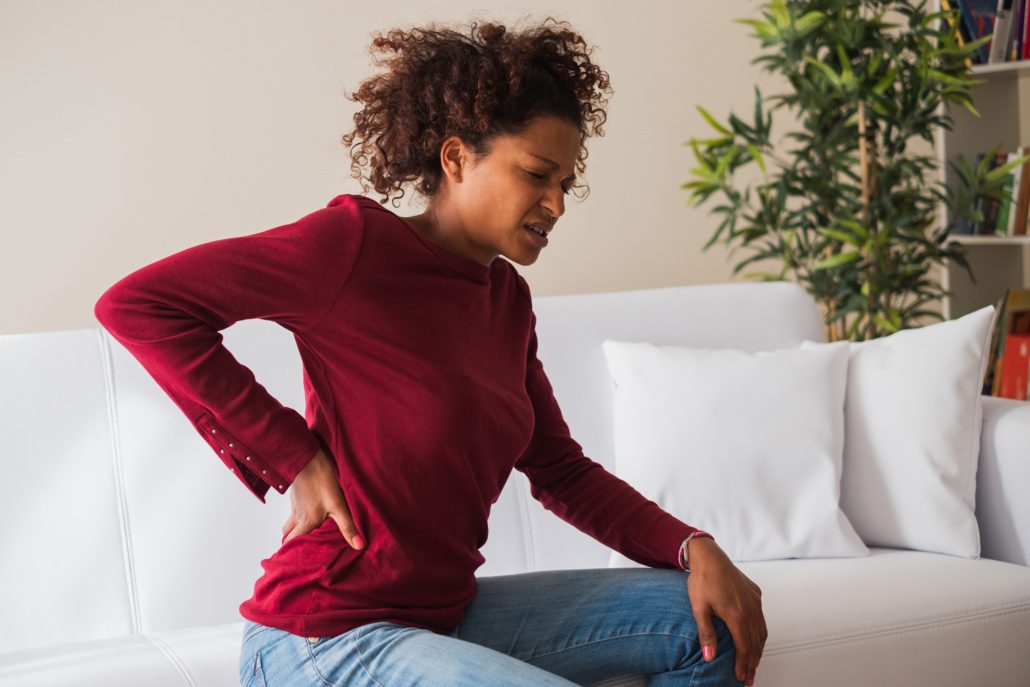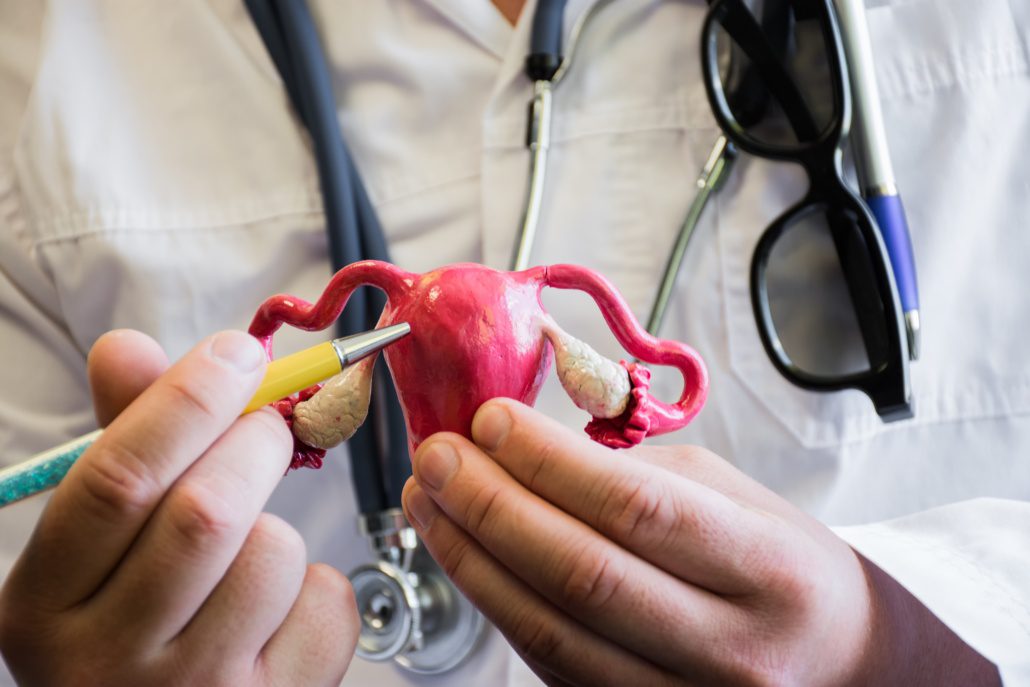Rectovaginal Endometriosis – Endometriosis with Intestinal Involvement
Rectovaginal endometriosis is a subtype of deep infiltrating endometriosis (DIE). When endometriosis lesions develop between the vagina and the bowel, it is termed rectovaginal endometriosis. On the other hand, deep infiltrating endometriosis involves the growth of endometriosis into organs or structures, such as the tissue between the bowel and vagina, rather than just on their surfaces.
If these endometrial lesions penetrate at least the outer wall of the bowel, it is referred to as deep infiltrating endometriosis with bowel involvement. This condition is observed in approximately 25% of all endometriosis cases [5]. Endometriosis of the rectovaginal septum can manifest with or without intestinal infiltration, and both forms can significantly impact a person’s fertility and overall quality of life. Affected individuals often report severe pain, particularly during sexual intercourse (dyspareunia) and defecation (dyschezia) [5].
Depending on the extent of the condition, the appropriate treatment and therapy require collaboration between specialized surgeons and urologists, working alongside gynecologists, to remove the affected tissue surgically.
Symptoms of Rectovaginal Endometriosis
In addition to the typical symptoms associated with endometriosis, rectovaginal endometriosis often presents with additional distinctive symptoms, such as infertility and intense pain during and outside menstruation [2].
The following symptoms may manifest:
- Pain and difficulty during bowel movement (dyschezia).
- Pain experienced during sexual intercourse (dyspareunia), which can also lead to loss of libido due to severe discomfort.
- Abdominal bloating, commonly called “endo belly,” which can also occur in other forms of endometriosis and cause significant pain.
- Rectal bleeding coinciding with the menstrual cycle.
- Severe abdominal pain.
- Nausea.
- Lower back pain, particularly in the lumbar region.
- Bowel function disturbances, including episodes of diarrhea and constipation.
- Rare instances of intestinal obstruction.
Diagnosis
The diagnosis of intestinal endometriosis can be challenging due to the wide range of symptoms associated with endometriosis.
A preliminary diagnosis is typically established based on symptom observation and pain assessment using a pain scale.
In the case of rectovaginal endometriosis, a critical diagnostic technique is a rectovaginal palpation. The physician simultaneously palpates the vagina and rectum during this examination using one finger each. This allows for a thorough evaluation of the area in between, often the site of rectovaginal endometriosis. An experienced examiner can often discern strong indications of rectovaginal endometriosis using this method.
Ultrasound imaging can also be a valuable diagnostic tool. Initially, the examination focuses on the uterus and ovaries. It is followed by an assessment of ovarian mobility and the “sliding sign,” which gauges the mobility of the uterus. Due to the rectovaginal adhesions, mobility may be restricted, and this limitation can be directly evaluated through ultrasound. Subsequently, a more comprehensive evaluation of involvement in the posterior and anterior compartments, including the bladder and intestine, is conducted [5]. Endosonography of the rectum can also provide valuable information in the diagnostic process.
In some cases, an MRI can offer further insights into the extent of endometriosis adhesions, particularly when determining whether endometriosis has already penetrated the bowel wall. This information is valuable for assessing potential interventions, such as bowel resection, before surgical procedures [3]. However, it is essential to note that a negative MRI result does not definitively rule out rectovaginal endometriosis.
Occasionally, a colonoscopy may be conducted, but since endometriosis typically forms on the external surface of the bowel and infiltrates inward, an unremarkable colonoscopy does not necessarily exclude the possibility of bowel endometriosis.
For precise information regarding the location of rectovaginal endometriosis, whether it is limited to the outer bowel wall or has breached it, surgical intervention via laparoscopy [3] is necessary. In certain instances, lesions may not be visible on ultrasound or endosonography, and the full extent of endometriosis becomes apparent only during laparoscopy. Consequently, decisions about potential bowel resection should also be made intraoperatively [3]. It is crucial to discuss the approach in cases of endometriosis near or on the bowel during pre-operative consultations to develop an “if-then” plan in collaboration with the surgeon.
Treatment
The treatment and therapy of endometriosis with bowel involvement [5] necessitates careful consideration of several factors, including:
- The patient’s age.
- The patient’s desire to have children.
- The extent of endometriosis.
- Impairment of adjacent organs.
- The presence of symptoms such as pain.
In cases where endometriosis of the rectum is an incidental finding without associated symptoms, surgical therapy may not be deemed essential according to clinical guidelines. However, in practice, rectovaginal endometriosis, in particular, often leads to problems and pain.
Given the involvement of organs like the intestine, it is advisable to conduct therapy in a specialized center to ensure the participation of other specialized departments, including intestinal surgeons.
Surgery is frequently required, especially in rectovaginal endometriosis that causes significant pain. Although medication can alleviate the pain, it does not eliminate the endometriosis. Hormone preparations commonly used for other forms of endometriosis can also be administered, including progestins, combined pills, GnRH agonists/antagonists, or levonorgestrel-releasing IUD [5]. Small-scale studies have indicated symptom improvement with vaginal hormone rings, making this an additional individualized option.
Surgical removal of the endometriosis lesions is often the preferred treatment for symptomatic endometriosis with bowel involvement. Surgical therapy is the most effective means of achieving long-term pain relief and potentially improving fertility [4].
However, the treatment choice should always be discussed individually with the appropriate medical center.
In deep-infiltrating endometriosis involving the bowel wall, bowel resection may be a viable option. Surgery involving organs such as the bladder, ureters, and bowel demands a well-trained and experienced team comprising gynecologists, surgeons, and urologists to ensure that the patient emerges from anesthesia with minimal damage.
Good to Know!
Before any surgical procedure, especially when the bowel is involved, it is imperative to have a comprehensive discussion about “if-then” scenarios during pre-operative consultations. The full extent of endometriosis will only become evident during the surgery, by which time you will already be under anesthesia. This necessitates discussing in each consultation how to proceed if the intestine is affected.
Surgery on the intestine, which may involve the removal of a section of the intestine, carries inherent risks. It is important to emphasize that a temporary artificial anus may be necessary based on the surgeon’s evaluation. This can later be reversed, so it is not a permanent alteration. However, since this procedure naturally affects the postoperative period, it should be thoroughly discussed with the doctor.
In the case of endometriosis within the intestine, a decision must be made whether to continue the operation immediately to remove all affected areas or to plan a second operation. The latter approach allows for a more detailed discussion of the extent and associated risks beforehand. This decision is highly individual, so seeking comprehensive information and perhaps considering it in advance is essential.
After the Operation
If the endometriosis is confined to the outer bowel and has not been breached, bowel resection is typically unnecessary. However, suppose a portion of the bowel had to be removed during the surgery. In that case, an artificial bowel outlet may be temporarily installed for a few weeks or months to allow the surgically treated areas to heal.
In numerous instances, resection can enhance fertility. According to a study, 44.6% of women of childbearing age could conceive after undergoing resection for deep infiltrating bowel endometriosis. Furthermore, laparoscopic colorectal resection for endometriosis has been linked to symptom relief and significantly improved the patient’s quality of life [1]. Following the surgery, patients receive individual counseling regarding potential drug therapy options, such as progestin. Additionally, they are advised to maintain a healthy diet tailored to endometriosis.
References
- Daraï E, Bazot M, Rouzier R, Houry S, Dubernard G. Outcome of laparoscopic colorectal resection for endometriosis. Curr Opin Obstet Gynecol. 2007 Aug;19(4):308-13. doi: 10.1097/GCO.0b013e328216f6bc. PMID: 17625410.
- Donnez J, Nisolle M, Gillerot S, Smets M, Bassil S, Casanas-Roux F. Rectovaginal septal adenomyotic nodules: a series of 500 cases. Br J Obstet Gynaecol. 1997 Sep;104(9):1014-8. doi: 10.1111/j.1471-0528.1997.tb12059.x. PMID: 9307527.
- Mangler, M, Medrano, N, Lanowska M, Bartley, J, Schneider, A, Köhler, C. Preoperative diagnosis of bowel involvement in rectovaginal endometriosis. in Obstetrics Gynecology 2007; 67 – A30.
- Mangler, M., Loddenkemper, C., Lanowska, M., Bartley, J., Schneider, A., Köhler, C. A combined surgical approach to the therapy of rectovaginal endometriosis based on histological findings. Journal of Gynecologic Endocrinology 2008; 2 (2) (issue for Austria). Gablitz.
- Tiringer, D, Husslein, H, Küssel, L, Wenzl, R. Diagnosis and therapy of “rectovaginal” or deep infiltrating “intestinal” endometriosis. 37th ed. 1/2019.
- “Take yourself and your endometriosis seriously. You are not imagining things!” - 7. November 2023
- Interview with Endometriosis Patient Nina - 7. November 2023
- Interview with Endometriosis Patient Nina - 7. November 2023



